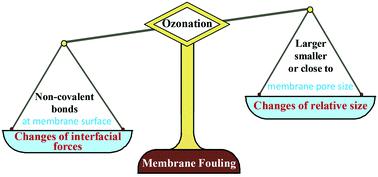当前位置:
X-MOL 学术
›
Environ. Sci.: Water Res. Technol.
›
论文详情
Our official English website, www.x-mol.net, welcomes your feedback! (Note: you will need to create a separate account there.)
Unravelling the critical mechanism by which pre-ozonation affects ultrafiltration membrane fouling via investigation of the relative size and interfacial forces
Environmental Science: Water Research & Technology ( IF 5 ) Pub Date : 2021-5-26 , DOI: 10.1039/d1ew00197c Rui Miao 1, 2, 3 , Xiaoyan Nie 1, 2 , Bingpeng Ma 1, 2 , Zihan Yang 1, 2 , Pei Wang 2, 3 , Lei Wang 1, 2 , Xiao-yan Li 3
Environmental Science: Water Research & Technology ( IF 5 ) Pub Date : 2021-5-26 , DOI: 10.1039/d1ew00197c Rui Miao 1, 2, 3 , Xiaoyan Nie 1, 2 , Bingpeng Ma 1, 2 , Zihan Yang 1, 2 , Pei Wang 2, 3 , Lei Wang 1, 2 , Xiao-yan Li 3
Affiliation

|
To date, the influence of pre-ozonation on membrane fouling behaviour remains vague, and contradictory phenomena have been reported. Hence, to better understand the essential mechanism by which pre-ozonation affects the ultrafiltration membrane fouling behaviour, the present experimental study was carried out on pre-ozonation of sodium alginate (SA) solutions prior to their filtration. The relative size of SA and membrane pores and the interfacial forces of SA at the membrane surface before and after pre-ozonation were systematically investigated, and their relationship with the membrane fouling rate was determined. The results showed that whether SA after pre-ozonation was larger than, smaller than, or similar in size to the membrane pores, the trend of variation of membrane fouling with an increasing ozone dosage remained consistent. The results suggested that the changes in the relative size between foulants and membrane pores after pre-ozonation were not associated with the membrane fouling rate. In contrast, the changes of the interfacial forces of SA at the membrane surface can well explain the membrane fouling behaviour after pre-ozonation. Ozonation was found to weaken hydrogen bonds and strengthen electrostatic repulsion between the membrane and SA and between SA molecules, which mitigated the deposition of SA onto the membrane surface and resulted in a loose fouling layer. This effect eventually caused the extent of SA fouling of the ultrafiltration membrane to gradually decrease with increasing ozone concentration.
中文翻译:

通过研究相对大小和界面力来阐明预臭氧化影响超滤膜结垢的关键机理
迄今为止,预臭氧化对膜结垢行为的影响仍然模糊,并且已经报道了矛盾现象。因此,为了更好地理解预臭氧化影响超滤膜结垢行为的基本机理,本实验研究是对藻酸钠溶液在过滤之前的预臭氧化进行的。系统地研究了预臭氧化前后SA与膜孔的相对大小以及SA在膜表面的界面力,并确定了它们与膜结垢率的关系。结果表明,预臭氧化后的SA大于,小于或等于膜孔,随着臭氧剂量的增加,膜污染的变化趋势保持一致。结果表明,预臭氧化后污垢物和膜孔之间相对尺寸的变化与膜污垢发生率无关。相反,SA在膜表面的界面力的变化可以很好地解释预臭氧化后膜的结垢行为。发现臭氧化作用减弱了膜与SA之间以及SA分子之间的氢键并增强了静电排斥力,从而减轻了SA在膜表面上的沉积,并导致污垢层疏松。这种作用最终导致超滤膜的SA结垢程度随着臭氧浓度的增加而逐渐降低。相反,SA在膜表面的界面力的变化可以很好地解释预臭氧化后膜的结垢行为。发现臭氧化作用减弱了膜与SA之间以及SA分子之间的氢键并增强了静电排斥力,从而减轻了SA在膜表面上的沉积,并导致污垢层疏松。这种作用最终导致超滤膜的SA结垢程度随着臭氧浓度的增加而逐渐降低。相反,SA在膜表面的界面力的变化可以很好地解释预臭氧化后膜的结垢行为。发现臭氧化作用减弱了膜与SA之间以及SA分子之间的氢键并增强了静电排斥力,从而减轻了SA在膜表面上的沉积,并导致污垢层疏松。这种作用最终导致超滤膜的SA结垢程度随着臭氧浓度的增加而逐渐降低。这减轻了SA在膜表面上的沉积,并导致疏松的污垢层。这种作用最终导致超滤膜的SA结垢程度随着臭氧浓度的增加而逐渐降低。这减轻了SA在膜表面上的沉积,并导致疏松的污垢层。这种作用最终导致超滤膜的SA结垢程度随着臭氧浓度的增加而逐渐降低。
更新日期:2021-05-26
中文翻译:

通过研究相对大小和界面力来阐明预臭氧化影响超滤膜结垢的关键机理
迄今为止,预臭氧化对膜结垢行为的影响仍然模糊,并且已经报道了矛盾现象。因此,为了更好地理解预臭氧化影响超滤膜结垢行为的基本机理,本实验研究是对藻酸钠溶液在过滤之前的预臭氧化进行的。系统地研究了预臭氧化前后SA与膜孔的相对大小以及SA在膜表面的界面力,并确定了它们与膜结垢率的关系。结果表明,预臭氧化后的SA大于,小于或等于膜孔,随着臭氧剂量的增加,膜污染的变化趋势保持一致。结果表明,预臭氧化后污垢物和膜孔之间相对尺寸的变化与膜污垢发生率无关。相反,SA在膜表面的界面力的变化可以很好地解释预臭氧化后膜的结垢行为。发现臭氧化作用减弱了膜与SA之间以及SA分子之间的氢键并增强了静电排斥力,从而减轻了SA在膜表面上的沉积,并导致污垢层疏松。这种作用最终导致超滤膜的SA结垢程度随着臭氧浓度的增加而逐渐降低。相反,SA在膜表面的界面力的变化可以很好地解释预臭氧化后膜的结垢行为。发现臭氧化作用减弱了膜与SA之间以及SA分子之间的氢键并增强了静电排斥力,从而减轻了SA在膜表面上的沉积,并导致污垢层疏松。这种作用最终导致超滤膜的SA结垢程度随着臭氧浓度的增加而逐渐降低。相反,SA在膜表面的界面力的变化可以很好地解释预臭氧化后膜的结垢行为。发现臭氧化作用减弱了膜与SA之间以及SA分子之间的氢键并增强了静电排斥力,从而减轻了SA在膜表面上的沉积,并导致污垢层疏松。这种作用最终导致超滤膜的SA结垢程度随着臭氧浓度的增加而逐渐降低。这减轻了SA在膜表面上的沉积,并导致疏松的污垢层。这种作用最终导致超滤膜的SA结垢程度随着臭氧浓度的增加而逐渐降低。这减轻了SA在膜表面上的沉积,并导致疏松的污垢层。这种作用最终导致超滤膜的SA结垢程度随着臭氧浓度的增加而逐渐降低。



























 京公网安备 11010802027423号
京公网安备 11010802027423号